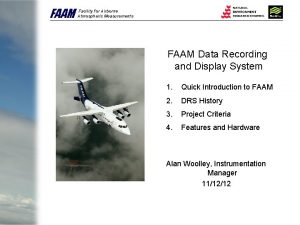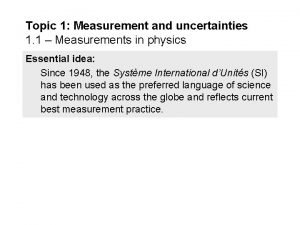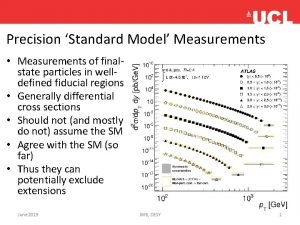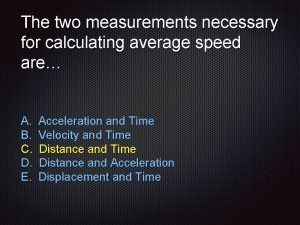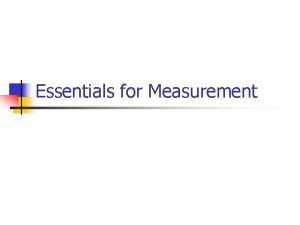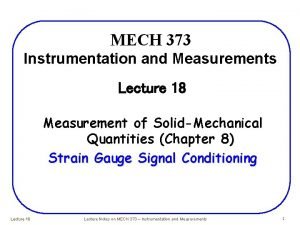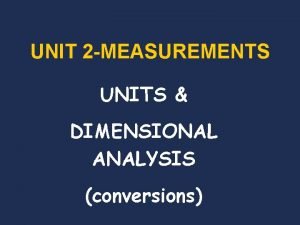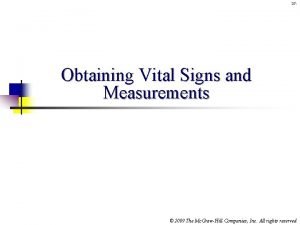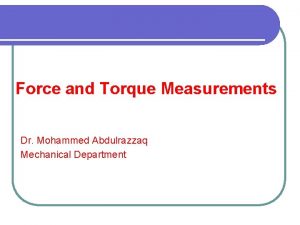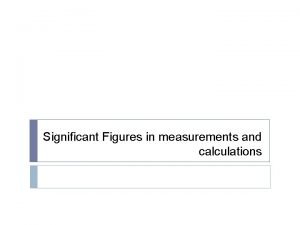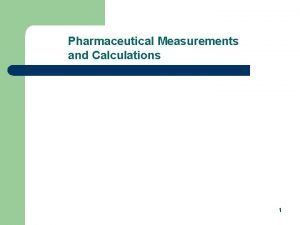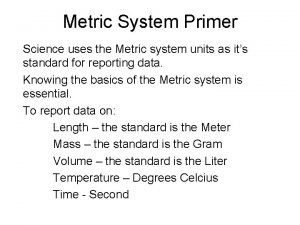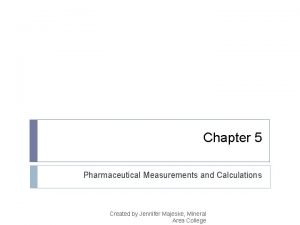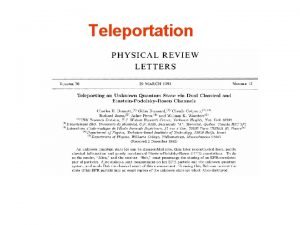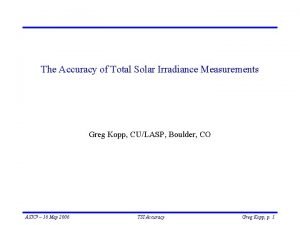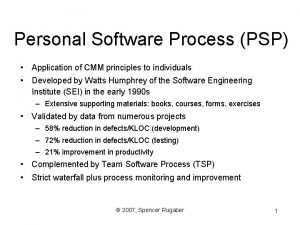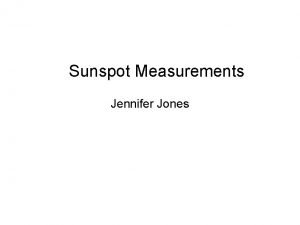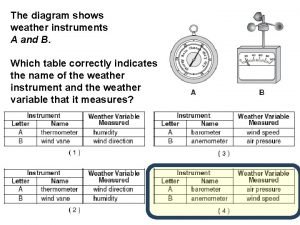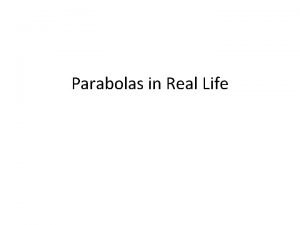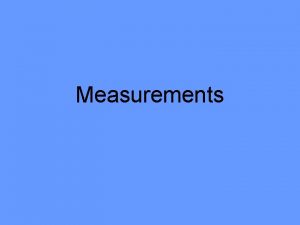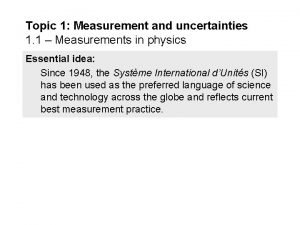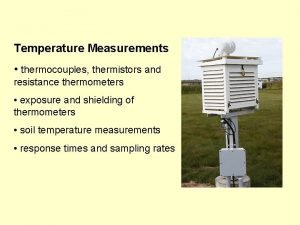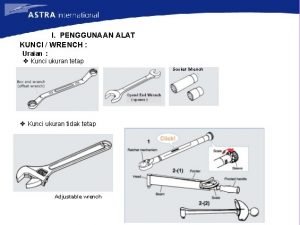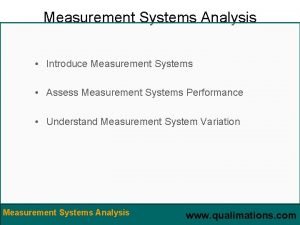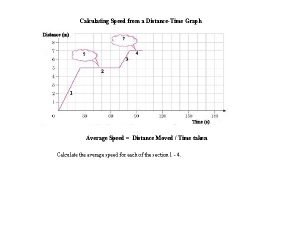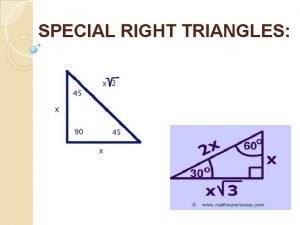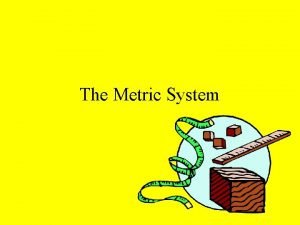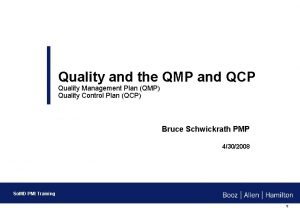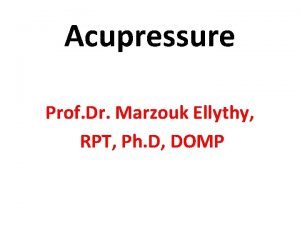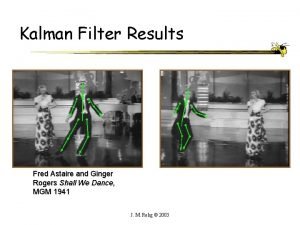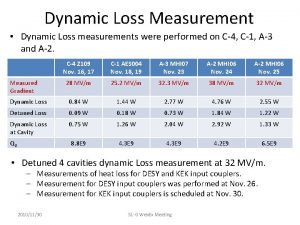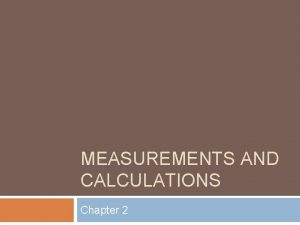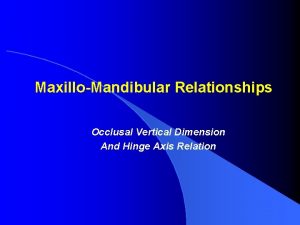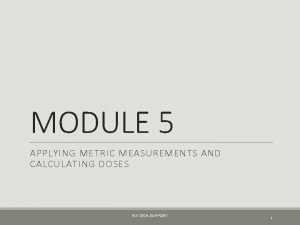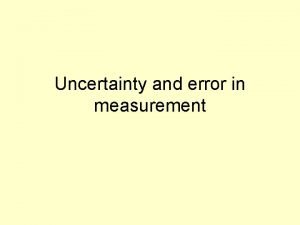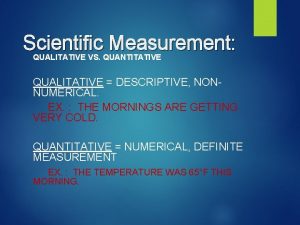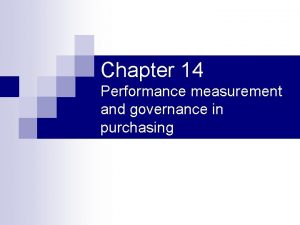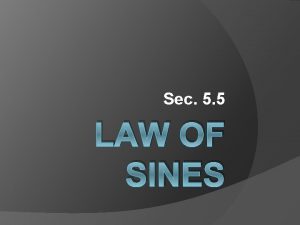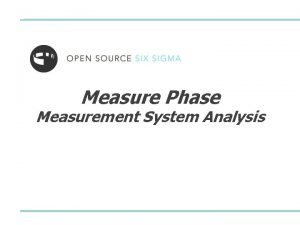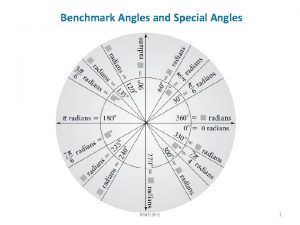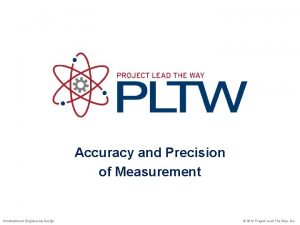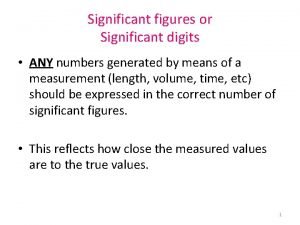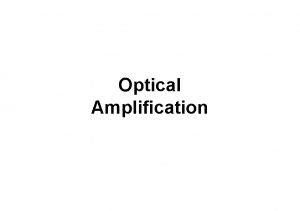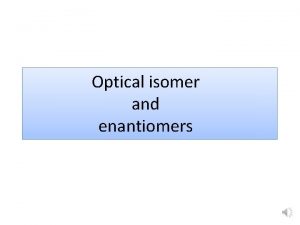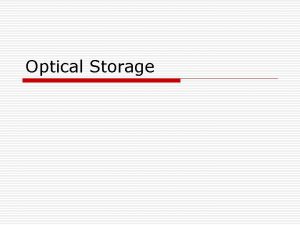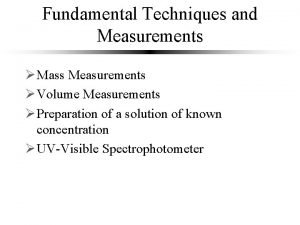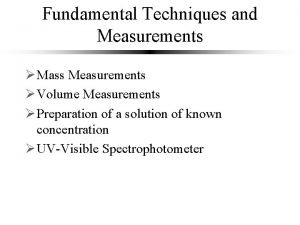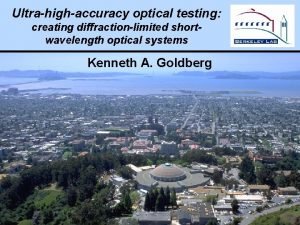Mike Harrop mike harropexfo com Advanced Optical Measurements


















































































































- Slides: 114

Mike Harrop mike. harrop@exfo. com Advanced Optical Measurements in Next Generation Networks October 2007

Agenda Introduction Digital Transmission Dispersion in optical Networks. Dispersion challenges for 40 G OSA challenges for 40 G/ROADM’s

What is the fundamental of digital transmission…? Tx Rx 101010010101010000100101010010101010 The Rx circuit is clocking at the system line rate and ‘simply’ needs to discern between a 1 and a 0 to recover the original signal.

The need for speed…

Eye diagram at Rx demonstrates signal quality Low BERT Intermediate BERT Unacceptable BERT

BERT causes a lot of pain to transmission groups Typical values for acceptable BERT levels: § >> 1 x 10 -12 § (or 1 bit error per 1, 000, 000 bits sent) In terms of Qo. S measurements: § single BIT error = 1 error second on the network Conclusion of high BERT: § Networks inability to operate at high speed § Poor Qo. S figures

What’s important in Optical Networks Source : British Telecom Laboratories Technical Journal 2003 (authors Sikora, Zhou and Lord), Advanced network parameters which have to be properly evaluated

What is Dispersion? In Out TX RX Dispersion is the time domain spreading or broadening of the transmission signal light pulses - as they travel through the fibre

Types of Dispersion • Chromatic Dispersion: • Different wavelengths travel at different velocities Pulse Spreading • Polarization mode dispersion: • Different polarization modes travel at different velocities Pulse Spreading

Types of Dispersion • Chromatic Dispersion: • Is deterministic • Is linear • Is not affected by environment • Can be compensated • Polarization mode dispersion: • Is stochastic • Is not linear • Is affected by the environment • Cannot be easily compensated

Mike Harrop mike. harrop@exfo. com Chromatic Dispersion October 2007

Chromatic Dispersion Issue Source wavelengths = do not propagate at the same speed, thus arrive at different times A pulse transmitted in such way suffers a spread, dispersion, limiting the transmission bandwidth. Pulse 1 2 3 Pulse Spreading 1 1 2 3 3

Visualizing CD Let’s visualize a light pulse travelling into a fiber and segment it into 9 quadrants (easier to visualize, and to draw!!!)

Visualizing CD Fiber length: Light pulse: Pulse width

Effects of Dispersion

Why is Measuring Dispersion so important? As transmission speeds go up, the residual dispersion allowable at the receiver to give a fixed system penalty goes down. Receiver Tolerance for a 1 d. B power penalty 2. 5 Gb/s 16, 000 ps/nm 10 Gb/s 1, 000 ps/nm 40 Gb/s 60 ps/nm e. g. An 80 km link at 1550 nm will build up 17 ps/(nm. km) x 80 km = 1360 ps/nm. Therefore at data rates at 10 Gb/s and higher it is necessary to compensate for the chromatic dispersion. To compensate effectively you need to measure the dispersion of the link.

16 times less CD, cause 1 Time slot 125 us Faster means less time between pulses

16 times less CD, cause 2 P The chirp effect P modulation @ 2. 5 Gb/s P @ 10 Gb/s Pulse before modulation P Faster means broader pulses @ 40 Gb/s

Dispersion Compensation Good News : CD is stable, predictable, and controllable. Dispersion compensating fiber (“DC fiber”) has large negative dispersion -85 ps/(nm. km) DC fiber modules correct for chromatic dispersion in the link delay [ps] d 0 Tx Rx fiber span DC modules

Dispersion Compensation for DWDM SMF-28 -D +D Dispersion (ps/(nm. km)) 18. 5 17. 0 16. 2 SMF after 80 km 1296 ps/nm @ 1530 nm 1360 ps/nm @ 1550 nm 1480 ps/nm @ 1570 nm Using 16 km of DCF @ 85 ps/(nm. km). 0 1300 1530 1550 1570 Wavelength (nm) -85 DCF Slope = 0 ps/nm^2/km Consider 3 channel SMF system Distance Gives a residual dispersion of -64 ps/nm @ 1530 nm 0 ps/nm @ 1550 nm 120 ps/nm @ 1570 nm

Dispersion Compensation for DWDM Dispersion compensation modules can only compensate exactly for one wavelength DWDM system design requires knowledge of end-to-end CD as a Dispersion function of wavelength… especially for long-haul -D +D +D 10 Gb/s Tolerance 40 Gb/s Tolerance Transmission path For 40 Gb/s transmission slope compensators will be required.

CD: Bad compensation

Dispersion Compensation for DWDM Note. In practise system vendors don’t compensate perfectly for CD at each stage. Usually a system will be pre-compensated and then not brought back to zero during transmission. This is to avoid additional non-linear penalties such as Four Wave Mixing and Cross Phase Modulation. Dispersion -D -D +D +D +D DRes Transmission path D Accumulated Z

Types of Dispersion • Chromatic Dispersion: • Different wavelengths travel at different velocities Pulse Spreading • Chromatic Dispersion: • Is deterministic • Is linear • Is not affected by environment • Can be compensated

Chromatic Dispersion - Conclusion For 10 Gbits/s and higher DWDM systems we need to measure both the dispersion and the slope accurately. Many ways to measure CD in fibre but with the tolerances required for accurate compensation – the only accepted method for making this measurement with this sort of accuracy is the Phase shift method

Mike Harrop mike. harrop@exfo. com Measuring Chromatic Dispersion October 2007

Chromatic dispersion Measurement Method- Phase Shift FOTP-169 Patented FTB-5800 method: Source Oscillator Optical filtering DUT or FUT Phasemeter

Chromatic dispersion Measurement Method- Phase Shift FOTP-169 RGD 1 Ref l Test l 1 Few kms of fiber

Chromatic dispersion Measurement Method- Phase Shift FOTP-169 RGD 2 Ref l Test l 2 Few kms of fiber

Chromatic dispersion Measurement Method- Phase Shift FOTP-169 RGD 3 Ref l Few kms of fiber Test l 3 ADVANTAGES: - More points: more resolution - Ideal for compensation - Ideal for complex networks

Reference and Measured Spectral Regions The system compares spectral regions about 1 nm width (A, B, …) with a reference to find the relative group delay and compute CD

Measuring CD Delay points are acquired Delay (ps) Lamdba Points are fitted according to models Delay (ps) 60 Lamdba 50 40 30 CD (ps/nm) 20 10 0 Slope of Delay gives CD Lamdba

RGD Fitting n The by-default or user selected mathematical model is fitted to the RGD point using the generalized least square method. u 3 -term Sellmeier (Standard fiber) u 5 -term Sellmeier u Lambda Log Lambda u Cubic (Unknown fiber, flattened fiber and amplified links) u Quadratic (Compensating, DSF and NZDSF fibers) u Linear

Standard Fiber

Standard Fiber Extrapolated 0 = 1320. 14 nm CD at 1550 nm = 16. 641 ps/nm. km

DSF Fiber 0 = 1547. 754 nm

NZDSF fiber (True Wave®) Example of NZDSF Analyzed with the help of the FTB-5800

Specifications Good repeatability Good accuracy

Measuring Chromatic Dispersion EXFO FTB-5800 l l l l Industry leading accuracy on CD and Slope Ideal for 10 G-40 G compensation Source Shape insensitivity EDFA testing l time saving Component characterisation Fast measurement Powerful but simple software

Mike Harrop mike. harrop@exfo. com Polarization Mode Dispersion October 2007

Reminder • Polarization mode dispersion: • Different polarization modes travel at different velocities Pulse Spreading • Polarization mode dispersion: • Is stochastic • Is not linear • Is affected by the environment • Cannot be easily compensated

Visualizing PMD Let’s visualize a light pulse travelling into a fiber and segment it into 9 quadrants (easier to visualize, and to draw!!!)

Visualizing PMD Fiber section: Light pulse: Pulse width

PMD Impact If we transmit 1 -0 -1: 1 0 1 With PMD, this becomes: 1 0 1 The « 1 » is dimmer, the « 0 » can have light: BER

What causes PMD Asymmetries in fiber during fiber manufacturing and/or stress distribution during cabling, installation and/or servicing create fiber local birefringence. A "real" long fiber is a randomly distributed addition of these local birefringent portions.

What causes PMD? Fiber defects Geometric Environmental constraints Internal Stress Lateral Pressure Wind (aerial fibers) Heat Bend

Small Birefringence

Small Birefringence

Small Birefringence

Small Birefringence

Small Birefringence

Small Birefringence

Small Birefringence

Small Birefringence Fast Slow

Large Birefringence

Large Birefringence

Large Birefringence

Large Birefringence

Large Birefringence

Large Birefringence Fast Slow

Birefringence and mode coupling

Birefringence and mode coupling

Birefringence and mode coupling

Birefringence and mode coupling

Birefringence and mode coupling

Birefringence and mode coupling

Birefringence and mode coupling

Birefringence and mode coupling

Birefringence and mode coupling

Birefringence and mode coupling

Birefringence and mode coupling

Birefringence and mode coupling

Birefringence and mode coupling

Birefringence and mode coupling

Birefringence and mode coupling

Birefringence and mode coupling

Birefringence and mode coupling Fast Slow

Causes of PMD Birefringence (Bad) § Introduced during manufacture § non uniform intrinsic fibre stresses ie core concentricity § non uniform extrinsic stresses ie pressure Mode coupling (Good) § fibre bend and twist § in-built stress in “spun” fibre § splices

PMD - Lower Bit Rate T 0 T t Dt fast axis slow axis z, t Dt

PMD - Higher Bit Rate Dt t fast axis slow axis z, t Dt

PMD vs Wavelength and Time Pradeep Kumar Kondamuri and Christopher Allen Information and Telecommunications Technology Center, The University of Kansas, Lawrence, Kansas, 66045 Douglas L. Richards Sprint Corporation, Overland Park, Kansas

1 d. B Penalty probability: Very low Low PMD average System Tolerance Average PMD

1 d. B Penalty probability: low Limit PMD average System Tolerance Average PMD

1 d. B Penalty probability: very high Too high PMD average System Tolerance Average PMD

PMD Power Penalty A PMD outage is when the instantaneous DGD exceeds a given threshold (Max DGD) A factor 3 between Max DGD and Average PMD is taken from a number of ITU‑T Recommendations (including G. 959 -1 OPTICAL TRANSPORT NETWORK PHYSICAL LAYER INTERFACES) for 99. 9954% of no PMD problems Once you know the system tolerance (Max DGD), aim at PMD < 1/3 of this value if you transmt Sonet/SDH

PMD Pass-Fail criteria ITU-T G. 959. 1, version 7. 6 defines Max DGD as 3*<DGD> It also defines Max DGD as 30 ps for OC-192 ITU-T G. 650 places it at 25 ps Max DGD, but this is based of FIBER, with no allowance to components. Good for Fiber Manufacturer, too tight for NSP IEEE-802. 3 ae has Max DGD at 19 ps (10 Gig. E), and with a tolerance of 99. 999987% (Corporation, Banks, etc need higher security) Max DGD is divided by 3. 73 for this level

PMD vs Outage probability System vendors give Max DGD. You choose Outage probabliity, then calculate PMD to achieve

Digital Transmissions PMD Specifications Maximum PMD value to ensure 99. 9954% probability that the tolerable broadening will correspond to a mean power penalty of 1 d. B. SONET-SDH Bit rate (Gbit/s) Average PMD* (ps) 2. 5 40 10 10 40 2. 5

Digital Transmissions PMD Specifications Maximum PMD value to ensure 99. 999987% probability that the tolerable broadening will correspond to a mean power penalty of 1 d. B 10 Gig. E Bit rate (Gbit/s) 10 Average PMD* (ps) 5

Total PMD vs PMD Coefficient Total link PMD (ps) 10 ps over 400 km 5 ps over 50 km Which is better? PMD Coefficient (ps/√km) used by fibre & cable manufacturers, based on ITU recommendations that a network will be 400 km. For 10 G Total limit is 10 ps, using our network length of 400 km gives: 10 ps = 0. 5 ps/ √km √ 400 km

Typical values for new fibre. G. 652 Standard Single Mode <0. 1 ps/ km G. 655 NZDSF <0. 04 ps/ km e. g. For a 80 km SMF link you would expect to see 0. 1 x sqrt(80 km) = 1 ps Delay For a 80 km NZDSF link you would expect to see 0. 04 x sqrt(80 km) = 0. 36 ps Delay Installed base?

Installed Base 10 G 40 G Source: John Peters, Ariel Dori, and Felix Kapron, Bellcore

Reminder • Polarization mode dispersion: • Different polarization modes travel at different velocities Pulse Spreading • Polarization mode dispersion: • Is stochastic • Is not linear • Is affected by the environment • Cannot be easily compensated

Pitfalls • Chromatic Dispersion: • Should be specified at the cable specs (install or rental of dark fiber) • Should be tested/compensated on installation or ahead of system turn up • Should be considered very deeply for DWDM systems • Polarization mode dispersion: • Should be specified at the cable spec level (install or rental of dark fiber) • Fibers should be tested and classified for suitability of different lines speeds • High levels could mean very costly re-engineering

Conclusions Uncontrolled fiber dispersion leads to increased BERT and lower Qo. S metrics Dispersion should be considered mission critical to any operator considering high speed digital transmission Accurate measurement and interpretation of those data are critical…

Mike Harrop mike. harrop@exfo. com Measuring Polarization Mode Dispersion October 2007

TIA/EIA FOTP 124 : Polarisation Mode Dispersion for Single-mode fibres by Interferometry. Interferometer Traditional Interferometric Method (TINTY) Limitations FUT Gaussian Interferogram Broadband Polarizer Smooth ripple free, Source. Gaussian like source Ideal random coupling DUT Analyzer Mirror Detector Autocorrelation Peak Cross correlation Gaussian fit Half width

FOTP-124: Are these Gaussian? ? ? Saudi Arabia: South Africa:

FOTP-124: Are these Gaussian? ? ? USA: UK:

FOTP-124: Are these Gaussian? ? ? UK:

Autocorrelation: source shape Source Shape Infinitely broad source Auto-correlation Infinitely thin line Add Autocorrelation to Crosscorrelation Broad uniform Very thin peak ? Odd-looking spectrum Broad peak, humps, ripple, etc…

TIA/EIA FOTP 124 a : Polarisation Mode Dispersion for Single-mode fibres by Interferometry. Interferometer Generalised Interferometic Method (GINTY) FUT No Limitations Polarizer No reliance on. Broadband Gaussian Interferogram Source Any fibre or component can be measured Any source shape acceptable Analyzer Mirror PBS Detectors

FOTP-124 6. 1. 2 PMD Calculation for Fibers with Strong Mode Coupling The PMD delay, <Dt>, is determined from the half width parameter, se, of the Gaussian curve fitting applied to the interferogram according to: Where se is the RMS width of the Gaussian calculated from the interferogram… 6. 2 Accuracy is related to the capability to precisly fit the interferogram with the Gaussian function…

What do the standards say? Ref. IEC 61282 Fibre Optic communication system design guides – Part 9: Guidance on PMD measurements and theory

Measuring PMD FTB-5500 B: l Highest accuracy and resolution l l Source Shape insensitivity l l l Ideal for 10 G-40 G compliance & certification Test the whole link EDFA, OADM testing Fast measurement time Powerful but simple software Same source as FTB-5800 CD Analyzer

Mike Harrop mike. harrop@exfo. com Polarization Optical Time Domain Reflectometer October 2007

What to do with a link with high PMD? Frequent PMD problems (not measured when built) Need a way to find high PMD sections: PMDTOT = N(PMDN)2 Example: 15 ps, 2 ps, 1 ps, 6 ps 225 ps 2 + 4 ps 2 + 1 ps 2 + 36 ps 2 = 266 ps 2 2661/2 = 16. 31 ps Find the 15 ps section, replace it, problem solved…

Birefringence & Mode Coupling Fibres with short (h) where Fast & Slow axis change frequently, tend to have low PMD Fibres with long (h) where Fast & Slow axis Change infrequently, tend to have high PMD fast slow h slow fast slow

DOP Polarization-OTDR Pulsed DFB Laser SOP 1/SOP 2 fiber under test /4 4 x 2 OTDR acquisitions for characterizing SOP(z) Detector Polarizer /4 Polarimeter Quantitative b = not measured PMD value not measured DOPSOP 1, DOPSOP 2, h and L = all measured Tendency for High PMD

Example of Measurement and Validation (1) 29 km 5 km 7 km Link Length ~ 41 km PMD = 9. 8 ps PMDcoefficient ~ 3 ps/ km Cable opened and PMD measured with EXFO FTB-5500 B PMD test set: 29 km, PMD = 4. 3 ps High Contrast 5 km, PMD = 17. 4 ps 7 km, PMD = 6. 9 ps

Example of Measurement and Validation (2) 35 km 6 km Link Length ~ 41 km PMD = 9. 8 ps PMDcoefficient ~ 1. 53 ps/ km Cable opened and PMD measured with EXFO FTB-5500 B PMD test set: 6 km, PMD = 9. 25 ps High Contrast

Bi-directional Measurements Quite similar results

Fiber Mapping in a Cable km 0 3 6 9 12 15 18 21 24 27 30 33 36 39 42 45 48 51 54 57 60 63 Fiber PMD # (ps) 1 1 7. 6 2 2 19. 4 3 3 12. 4 4 4 3. 7 5 5 8. 4 6 6 8. 8 7 7 8. 2 8 8 15. 7 9 9 2. 5 10 10 28. 1 11 11 9. 5 Source: Connibear, A. B. and Leitch, A. W. R. , Uni. Port Elizabeth, “Locating High PMD Sections of an Overhead Cable Unsing Polarization OTDR” PMD Fiber # (ps) Open and test Replace PMD (ps) and retest 40. 6 -49. 6 km fiber# 1 7. 6 1. 7 2 19. 4 18. 5 3 12. 4 7. 2 2. 9

Questions?
 Mike harrop
Mike harrop Cơm
Cơm Dậy thổi cơm mua thịt cá
Dậy thổi cơm mua thịt cá Dyson harrop satellite
Dyson harrop satellite Dr adrian harrop wikipedia
Dr adrian harrop wikipedia Fpds lunch menu
Fpds lunch menu Slidetodoc
Slidetodoc Facility for airborne atmospheric measurements
Facility for airborne atmospheric measurements Measurement topic
Measurement topic Measurement uncertainty
Measurement uncertainty Greek god measurements
Greek god measurements Angle measurements and segment lengths
Angle measurements and segment lengths Standard model measurements
Standard model measurements Ellipse conic section examples in real life
Ellipse conic section examples in real life Mathematical literacy grade 10 measurements
Mathematical literacy grade 10 measurements What two measurements are necessary for calculating speed?
What two measurements are necessary for calculating speed? Basic requirements of measurement
Basic requirements of measurement Specialized measurements
Specialized measurements Palatine fovea
Palatine fovea Instrumentation and measurements
Instrumentation and measurements Dimensional analysis formula
Dimensional analysis formula 4 types of physiological measurements
4 types of physiological measurements Conversions in maths lit grade 12
Conversions in maths lit grade 12 Vital sign gloves
Vital sign gloves Mathematical literacy grade 10 measurements
Mathematical literacy grade 10 measurements Vital signs and measurements chapter 37
Vital signs and measurements chapter 37 Absolute uncertainty multiplication
Absolute uncertainty multiplication Using and expressing measurements
Using and expressing measurements Force and torque measurements
Force and torque measurements Sig figs on a thermometer
Sig figs on a thermometer Weights and measure training
Weights and measure training Face bone structure
Face bone structure Laurel goodwin measurements
Laurel goodwin measurements Cs6250 bgp measurements
Cs6250 bgp measurements Two types of measurements
Two types of measurements Pharmaceutical measurements and calculations
Pharmaceutical measurements and calculations English system of measurements
English system of measurements Pharmaceutical measurements and calculations
Pharmaceutical measurements and calculations Household conversions
Household conversions Bell measurements for teleportation
Bell measurements for teleportation Measurements
Measurements What is psp in software engineering
What is psp in software engineering Active range of motion definition
Active range of motion definition Md solarscience
Md solarscience Force gnss measurements
Force gnss measurements Kathleen quinlan smoking
Kathleen quinlan smoking Joy of fitness
Joy of fitness How to measure triple jump
How to measure triple jump The diagram below shows a weather instrument
The diagram below shows a weather instrument Gdp types
Gdp types Teaspoon abbrevation
Teaspoon abbrevation Conic sections
Conic sections Examples of measurement
Examples of measurement Standard model measurements
Standard model measurements Metric system units
Metric system units Types of linear measurement
Types of linear measurement Measurement grade 10
Measurement grade 10 For adult
For adult It consists of numbers representing counts or measurements.
It consists of numbers representing counts or measurements. Measurements in physics
Measurements in physics Measurements in chemistry
Measurements in chemistry Colour code detector
Colour code detector 3 units of linear measurements in metric system
3 units of linear measurements in metric system Ee8403 measurements and instrumentation
Ee8403 measurements and instrumentation Units of length
Units of length Key measurements
Key measurements Measurements system analysis
Measurements system analysis Imperial system
Imperial system What two measurements are necessary for calculating speed
What two measurements are necessary for calculating speed Diamtral
Diamtral Njrotc sdb
Njrotc sdb Right triangle formula
Right triangle formula What was the significance of the metric act of 1866
What was the significance of the metric act of 1866 Table of conversion of measurement
Table of conversion of measurement Dr katherine kuhlman measurements
Dr katherine kuhlman measurements Qcpxxi5obqc -site:youtube.com
Qcpxxi5obqc -site:youtube.com Measurements
Measurements Cun measurements tcm
Cun measurements tcm Standard deviation of repeated measurements
Standard deviation of repeated measurements Ginger rogers measurements
Ginger rogers measurements God genesis
God genesis Dynamic loss
Dynamic loss Anthropometric indicators
Anthropometric indicators How to calculate percent error in chemistry
How to calculate percent error in chemistry Alley dock backing
Alley dock backing Wax rim dimensions
Wax rim dimensions General physics chapters
General physics chapters Young rule
Young rule Kitchen measurements abbreviations
Kitchen measurements abbreviations Measurements of money
Measurements of money Random errors may be detected by repeating the measurements
Random errors may be detected by repeating the measurements Si unit in science
Si unit in science Lauren casey measurements
Lauren casey measurements Purchasing goals measurements
Purchasing goals measurements State whether the given measurements determine zero
State whether the given measurements determine zero Imperial system
Imperial system Pan flute wiki
Pan flute wiki Measure phase steps
Measure phase steps Instrumentation and measurements
Instrumentation and measurements Special triangles
Special triangles Metrology and measurements subject code
Metrology and measurements subject code Mitral stenosis measurements
Mitral stenosis measurements Measurements
Measurements Transverse horizontal axis of mandible
Transverse horizontal axis of mandible Measurements of elasticity of demand
Measurements of elasticity of demand Android force full gnss measurements
Android force full gnss measurements Barbara hale measurements
Barbara hale measurements Precise measurements are always accurate
Precise measurements are always accurate Using and expressing measurements
Using and expressing measurements Slidetodoc.com
Slidetodoc.com Chapter 2 measurements and calculations
Chapter 2 measurements and calculations Significant figures definition
Significant figures definition Measurements and scientific tools lesson 2
Measurements and scientific tools lesson 2 Anthropometric measurement includes vital signs
Anthropometric measurement includes vital signs Nursing metric conversion chart
Nursing metric conversion chart







